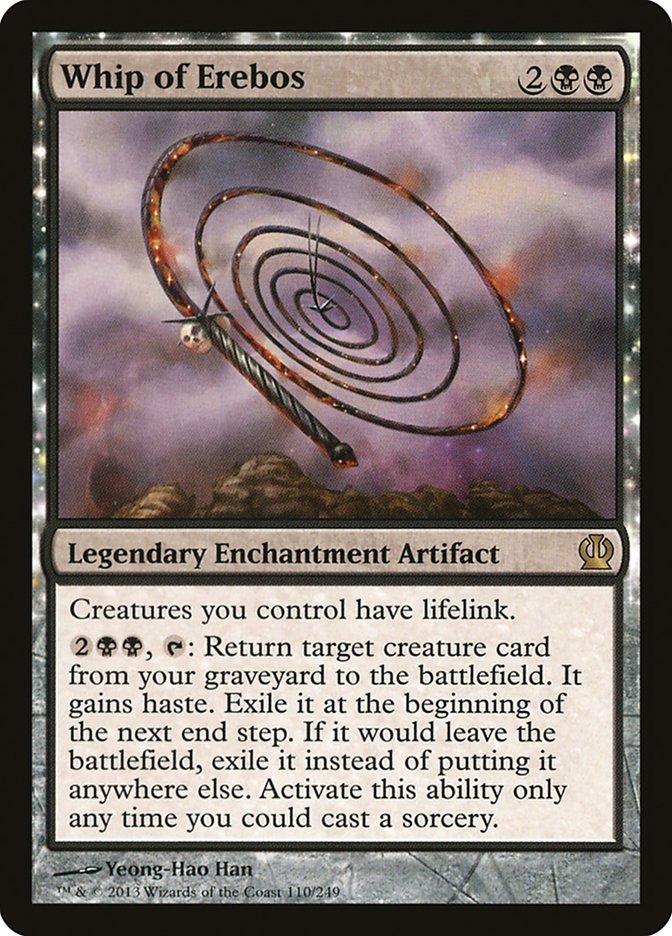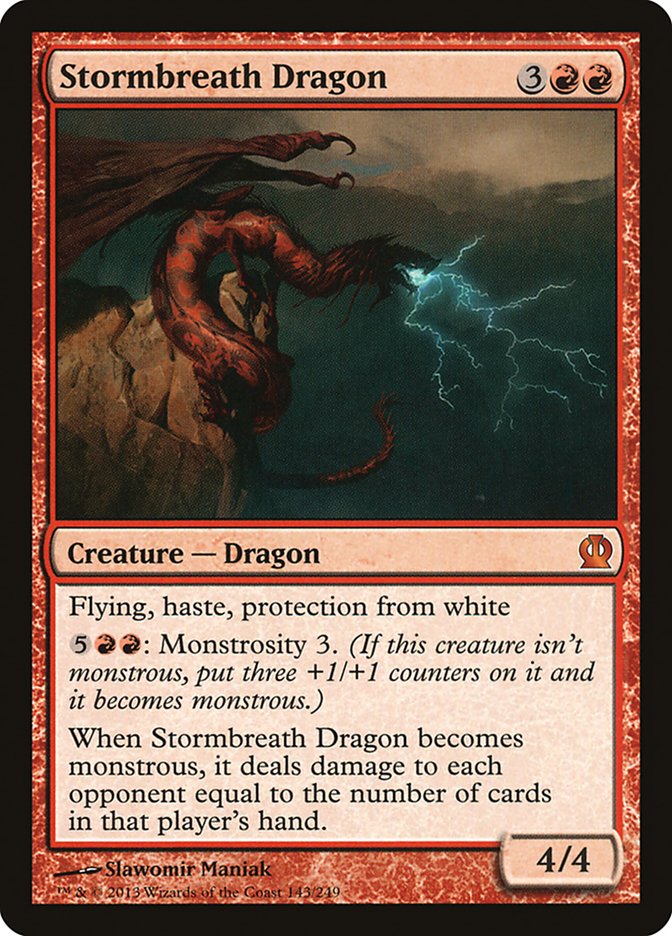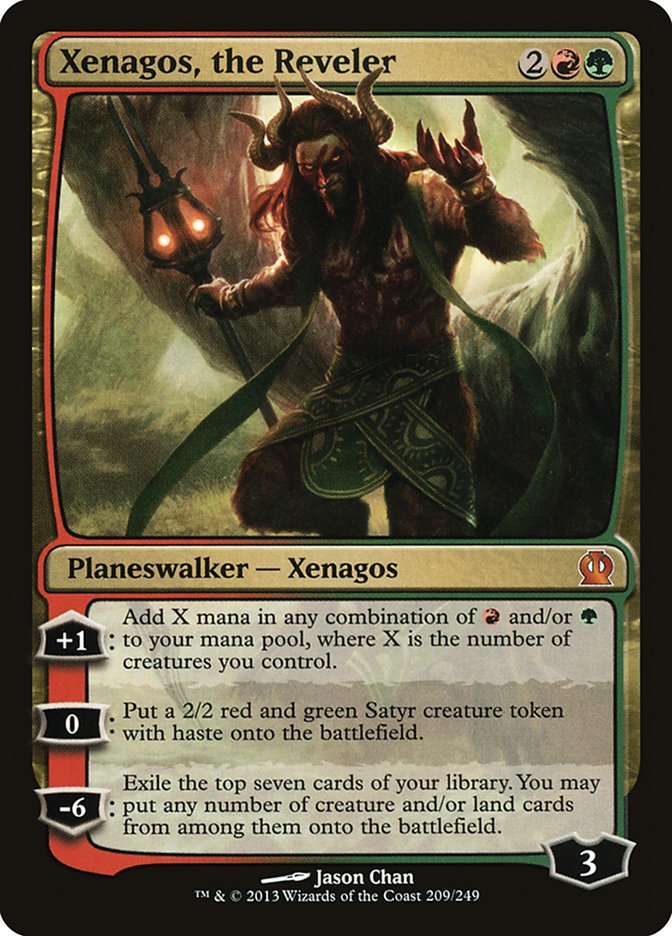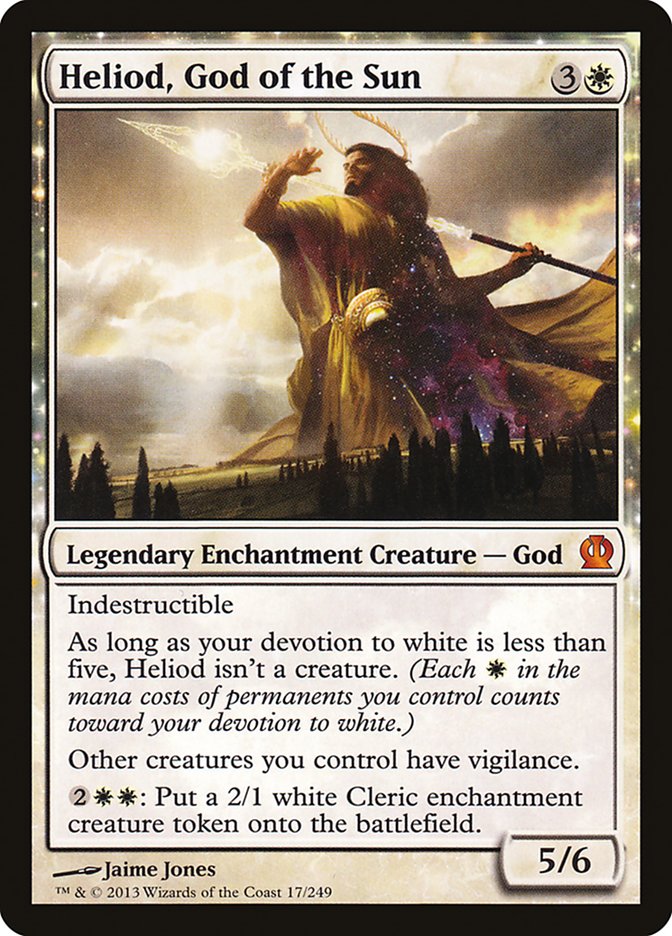I found a deck I loved. It was the last week of the Standard season, and I toiled on a deck I wish I had worked on sooner. B/W Tokens, an old favorite of mine, was brought forth from the ashes for an 8-2 finish at SCG Standard Open: Atlanta, only to die again immediately afterward. I enjoyed the deck, but I won’t play that ever again because I can’t. It was one last hurrah. Buh-bye Innistrad. The format changes.
While the theme of Innistrad was darkness, Theros has a bit of a different approach. Theros is like the Texas of Magic. Everything is just bigger there. Bigger-than-life monsters battle it out against actual gods. What can one whip do against a hundred hands? What can one bow do against the breath of the storm?
Worlds? Eaten.
Polis? Crushed.
Oxen? Yoked.
Theros is nobody’s b****.
Unfortunately, the same cannot be said of Erebos. It turns out that he’s actually Heliod’s b****. Is Heliod gonna have to spear a . . .
If Theros is all about being big, then two things are apparent. First, Shaquille O’Neil would probably X-0 his Prerelease. Secondly, it would be a shame to do anything but talk about some of the biggest effects I see in the set. So let’s do that.
Despite what I said about him earlier, Erebos has got a pretty devastating Whip. He doesn’t like to Ereboast, but he ended up with one of the best weapons. It may not be a Greek comedy, but I still want to get people with this slap stick.
Whip of Erebos
I think this is one of the most powerful cards in the set. It also happens to be my favorite card from the set. Let’s take a look at some of the effects black has access to right now. Thoughtseize. Read the Bones. Erebos, God of the Dead. Underworld Connections. Dark Prophecy. These cards all have something in common. They offer you an advantage at the cost of life. That’s not even taking into account the amount of damage you can deal to yourself over the course of a game just by playing shock lands untapped.
I think Whip of Erebos is almost playable just for the lifelink ability alone. Providing a way to gain back all the life that is lost from those cards is not irrelevant at all. In the case of Erebos, Read the Bones, Dark Prophecy, and Underworld Connections, that life directly contributes to extra cards. If you can keep the spice flowing, it’s pretty likely you can find a way to win the game with all the card advantage.
Having one hit from a Lifebane Zombie undo a Thoughtseize or one hit from an Obzedat undo a few turns’ worth of damage is actually pretty important. That’s one more Read the Bones. That’s one more activation of Underworld Connections. That’s the Thoughtseize that strips your opponent’s last card.
Beyond that is the ability to "unearth" creatures from your graveyard. Since I feel the lifelink ability is almost good enough by itself, I think this ability is essentially just a freeroll. I also think this ability works very well with the lifelink ability. Every time you Whip a creature back into play, you get to gain enough life to hopefully keep you alive long enough to repeat the process again.
The lifelink ability helps push the game much longer. The longer the game goes, the more and more value you will be able to get out of the resurrection ability. The two work hand in hand, and I think the sum of the parts is a very powerful card that will be a major player in Standard.
Level 1 is Whip of Erebos and Obzedat, Ghost Council. Last week, I played a deck built around this interaction in a Versus video against Charles VanMeter:
Creatures (19)
- 4 Desecration Demon
- 3 Obzedat, Ghost Council
- 4 Nightveil Specter
- 3 Tithe Drinker
- 3 Lifebane Zombie
- 1 Abhorrent Overlord
- 1 Erebos, God of the Dead
Lands (26)
Spells (15)

The basic premise of the deck is simple. Whip of Erebos returns a creature from your graveyard to the battlefield with the provision that you exile it in the next end step or if it leaves play for any reason in the meantime. Since Obzedat’s ability puts Obzedat into the exile zone, it satisfies the requirement of the Whip, and you are able to return Obzedat back to play in your next upkeep like normal as long as you resolve Obzedat’s trigger before the Whip’s.
As a result, you can make the hard task of killing Obzedat even harder. Not only does your opponent have to deal with it the first time, but they also have to deal with it the second time and only have a one-turn window to do so before it’s too late and Obzedat is back for good.
One thing to note is that although I like Desecration Demon a lot, I don’t think he is the right fit in a Whip deck unless you also have enough removal to clear a path. The lifelink and resurrection ability are both completely irrelevant with Desecration Demon if he just spends all his time tapped anyway.
Another card that likely deserves a spot in a deck with Whip of Erebos is Archangel of Thune. If you have multiple creatures with lifelink, they all separately trigger Archangel of Thune when they deal combat damage. Whip giving all of your creatures lifelink means that even something as simple as playing an Archangel onto a board with Whip in play and then hitting with two creatures will put two counters on all of your creatures. Not only would Archangel of Thune already be larger than Baneslayer Angel that turn, but she will have also buffed your entire board.
One minor theme I explored in this deck is devotion. I think another direction to take Whip of Erebos is to push that theme much harder. Since Whip is a permanent that will likely sit in play for a long time and also has a couple of black mana symbols in its cost, it’s very good for boosting devotion. In fact, I think it’s quite easy to increase your Devo as you Whip It.
Here’s a mono-black deck I like to call "Drain and Drain."
Creatures (17)
Lands (25)
Spells (18)

The basic idea behind this deck is to use cards like Underworld Connections, Read the Bones, and Erebos to dig you into Gray Merchant of Asphodel and Corrupt along with the necessary lands to cast them meaningfully. All of those draw effects come at the cost of life, but between Whip of Erebos, Gray Merchant of Asphodel, and Corrupt, you will eventually regain all of that life.
When you regain that life, you’re free to use it again to draw you into more copies of those cards and gain even more life.
The drain from Gray Merchant of Asphodel and Corrupt, along with the incidental damage that cards like Nightveil Specter and Lifebane Zombie can deal over the course of a game, means that in the process of looping life loss and card advantage with life gain you will also kill your opponent somewhere in the mix.
Whip of Erebos serves as a way to provide more life from your early creatures. Whip also lets you rebuy Gray Merchant of Asphodels to put even more pressure on your opponent. I can see this deck frequently putting the opponent in an awkward situation where they can’t attack into your Gray Merchant because they are just dead to you Whipping it back into play.
Underworld Connections and Pack Rat are both powerful cards in their own right, but they also provide a lot of devotion to Erebos and Gray Merchant. One neat thing about Pack Rat is that the copies actually provide devotion since they are actual copies of Pack Rat and have a mana cost as well. Pack Rat can also sometimes just win games on its own.
One final interaction I think is good with Whip of Erebos is the one between the Whip and Commune with the Gods. Since the Whip is an enchantment, Commune with the Gods actually lets you dig for it. If you already have a Whip, it digs for creatures and fills your graveyard for the Whip. Grisly Salvage is another great way to find creatures and fill your graveyard at the same time. Salvage doesn’t let you take Whip of Erebos, but it is still a fine card and a good way to dig for the God itself. Lotleth Troll lets you dump creatures from your hand to utilize the Whip quicker.
With a plethora of strong interactions like the ones above, I think G/B is a color combination that could also really end up benefitting from the Whip. Just because it doesn’t offer Obzedat doesn’t mean it should be ignored.
Stormbreath Dragon and Friends
This week, I played the following deck against CVM for our Versus video. I felt the deck was pretty good and with some tuning could be a major player in Standard.
Creatures (29)
- 3 Scavenging Ooze
- 4 Ghor-Clan Rampager
- 2 Ruric Thar, the Unbowed
- 4 Zhur-Taa Druid
- 4 Elvish Mystic
- 3 Polukranos, World Eater
- 1 Polis Crusher
- 4 Stormbreath Dragon
- 4 Boon Satyr
Planeswalkers (7)
Lands (24)

I played with a lot of new cards, but the most impressive card—and the one who gets the honor of headlining this section—is Stormbreath Dragon, or baby Tmaw.
I want to go on record saying that I hated Thundermaw Hellkite. I thought it was too good at what it did, which was removing any semblance of fun from a game of Magic. Maybe it was just me losing to the card a lot. Maybe it was the fact that Thundermaw did a huge number on some of my favorite cards in Standard: Lingering Souls, Restoration Angel, and Angel of Serenity.
At any rate, I simply didn’t enjoy Magic when that card was cast. It usually caused me to have a feeling of helplessness. I would be playing an otherwise interesting match of Magic. We would both be making decisions, trading creatures, trying to our advance our respective board states. We would be scrapping for any advantage we could. The only caveat was that there was an unspoken understanding by both players that if Thundermaw Hellkite was drawn the game would just end on the spot. "Guess I take a million and can’t block with anything."
I didn’t mind that it had haste. I didn’t mind that it killed one-toughness fliers. I hated that it tapped down flying creatures, especially in combination with the other two abilities. Not only could you not profitably block Thundermaw with any flying creatures, but you actually just couldn’t block anything. That Strangleroot Geist also gets to attack past your Vampire Nighthawk. That Flinthoof Boar can swing into your Restoration Angel now. Thundermaw rarely represented "just" five damage. Usually it was more like ten.
Stormbreath Dragon, while bearing a lot of similarities to Thundermaw Hellkite, doesn’t look like the kind of card that will frustrate me on anywhere near the same level. Protection from white means a flying white creature still can’t block it, but at least that creature can block other creatures. The monstrosity ability punishes opponents who try to ignore the card, but at the same time seven mana gives them the time they need to answer it.
The difference between four and five power is actually pretty significant. That’s usually enough to give your opponent one extra turn to answer your card.
All in all, I think Stormbreath Dragon is a more fair version of Thundermaw Hellkite, and I like it. As it turns out, being a worse version of Thundermaw Hellkite is still more than good enough.
Another card I want to talk about from the list is Xenagos, the Reveler. I’m not sure if this card will end up being that good in a list like this. Chandra, Pyromaster is already seeing play in Modern and Legacy, so it has tough competition.
With that being said, I like what Xenagos has to offer. One of the major selling points of this deck is that most of your creatures have multiple modes. You can cast Polis Crusher as a bad Ghor-Clan Rampager. But if you just so happen to go monstrous with him, he starts to look a lot like Ice Cube. Crush tha Polis. Polis Crusher is gonna take you out to a fancy dinner. He doesn’t mind footing the bill. A 7/7 trample that can also take out enchantments each and every time he connects is actually a scary card.
Likewise, Boon Satyr offers you bestow at five mana. Stormbreath Dragon and Polukranos, World Eater also have monstrous abilities. Scavenging Ooze has an activated ability that requires you pump mana into the Ooze.
For that reason Xenagos offers a lot with both his +1 and his +0 ability. The 0 ability applies hasted pressure to your opponent, much akin to Stormbreath Dragon. The +1 ability lets you generate enough mana to use all of your cards to their full extent. You can make a Satyr the first turn you play Xenagos and then go Monstrous the next turn with a Polukranos using the mana from Xenagos.
I also like that a mana accelerator into turn 3 Xenagos threatens a turn 4 Ruric Thar, the Unbowed. Without Thragtusk to hold him down, I think Ruric Thar is going to be a strong card in the new format, and having him in play on turn 4 is going to be painful for your opponent to deal with.
One final card I want to mention is Hammer of Purphoros. This card was in the sideboard, but I actually think it’s likely good enough to maindeck. One of the big advantages of G/R Aggro in the last Standard format was that all of your creatures for the most part had haste. That haste is what made the deck so hard to fight. At any time, they could draw something off the top and smash you for a lot that turn.
Hammer gives all of your creatures haste. It makes cards like Polukranos a lot stronger when you can hit your opponent for five on turn 4 and still have a massive creature capable of blowing up their board in play. Hammer, along with all the monstrous creatures, also hedges against flooding out. When you’re drawing too many lands, you can use them to make your monstrous creatures larger, or you can use them to generate 3/3 golems with haste. Having cards that help your game even when you’re drawing poorly is not to be underestimated.
If Hammer of Purphoros ends up being worth playing maindeck, it also means that Kalonian Hydra should be a consideration. Being able to attack for eight the turn you play the Hydra and threaten lethal the following turn from the Hydra alone is pretty scary. While Ogre Battledriver can do the same thing, it is a lot more vulnerable by virtue of being a creature.
Heliod, God of the Sun
The last card I want to talk about is Heliod, God of the Sun. I’ve heard a lot of people suggest that they think he is the worst God. In fact, he happens to be the God that is selling for the least amount on this website, which certainly supports that claim.
I think he could very well be the best God. I won’t definitively make that claim since it’s definitely hard to predict exactly what kind of impact they will all have, but Heliod is the only God that offers you an increasing advantage even when you don’t have devotion or anything else going on. Thassa lets you scry and Erebos lets you draw cards at the cost of life, but both of those abilities have diminishing returns and restrictions.
Heliod just lets you pump out more and more creatures. I also think that vigilance is an underrated ability and one of the most overlooked parts of the card. Vigilance sounds like a nightmare for your opponent when we’re dealing with such hits as Fiendslayer Paladin, Boros Reckoner, and Precinct Captain.
Creatures (27)
- 4 Precinct Captain
- 4 Syndic of Tithes
- 4 Boros Reckoner
- 4 Archangel of Thune
- 4 Fiendslayer Paladin
- 3 Heliod, God of the Sun
- 4 Soldier of the Pantheon
Planeswalkers (2)
Lands (26)
Spells (5)

The sideboard would contain Standard staples like Banisher Priest, Renounce the Guilds, Glare of Heresy, and Pithing Needle.
This deck contains a lot of synergies that I really like. For one, there is a lot of inherent life gain with Soldier of the Pantheon, Syndic of Tithes, Fiendslayer Paladin, and Path of Bravery. That life gain all turns on Archangel of Thune.
What goes well with an active Archangel of Thune? Lots of token generators, such as Precinct Captain, Heliod, and Elspeth, would be a good place to start. When you combine the two, you get a deck that generates a lot of creatures and triggers Archangel of Thune a lot of times. That sounds like a winning combo to me.
Even beyond that, there are a lot of first-strike creatures alongside Heliod, which gives them vigilance. That makes it difficult for an opposing deck to attack into this deck profitably, and your creatures get to play both offense and defense.
The final point is that Heliod himself presents a massive threat in this deck. All of the creatures have a heavy devotion to white, which should turn him into a creature fairly often. Beyond that, you can also just beat your opponent down with your repeated stream of 2/1 Clerics entering the fray.
Normally, you would think of a cleric as a fairly safe and peaceful individual. Perhaps a cleric is looking to heal some wounds rather than inflict them? That’s what I thought until I saw a card called Geist of Saint Traft, which ruined that imagine forever. So you know what? **** em. Let’s beat the s*** out of them with some Clerics. It worked for Geist of Saint Traft, and it will work for you.
Between Spear of Heliod, Path of Bravery, and Archangel of Thune, all of those Clerics have the potential to become massive threats. Thanks to Nykthos, Shrine to Nyx, it’s possible to generate a ton of mana to activate Heliod’s ability multiple times a turn.
All in all, I think Heliod is going to be a big part of Standard, and I am excited to play more with the card.
A lot of writers this week and last have included a section at the end of their article basically encouraging readers to submit brews in the comments. I like the idea of encouraging feedback and conversations about Theros, but I want to do it a bit differently. Instead of posting unrelated decks, how about we focus on these cards and these decks. What cards can make these decks better? What cards are missing from these decks? What other decks can these cards improve? I think a more focused approach is going to be much more successful overall.
So let me know what you think, and as always . . .
Thanks for reading.
Brian Braun-Duin
BBD on Magic Online
@BraunDuinIt on Twitter




